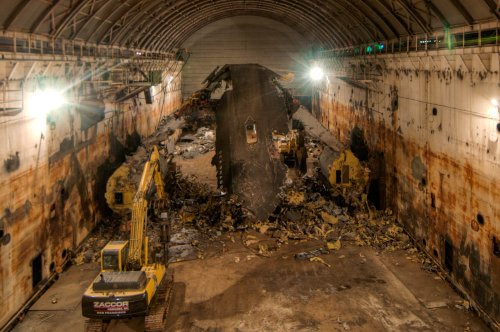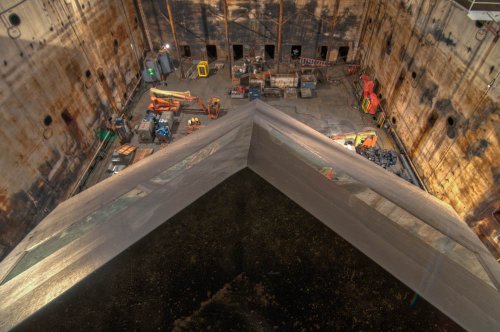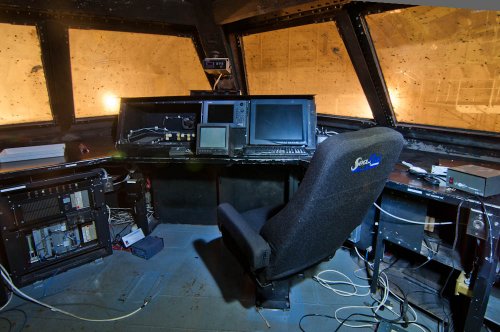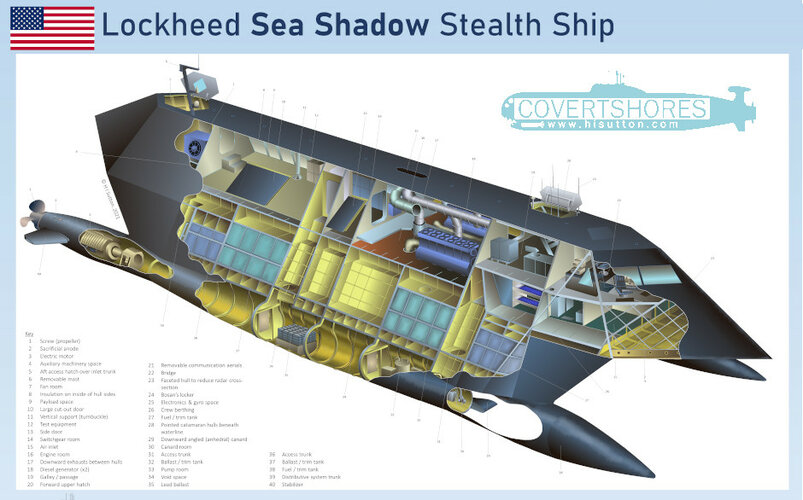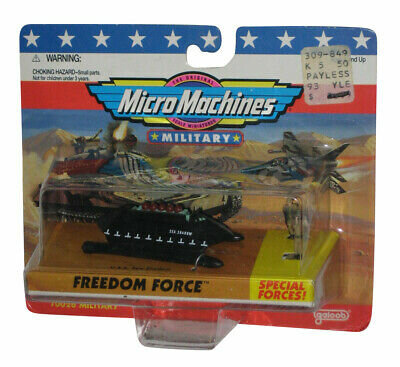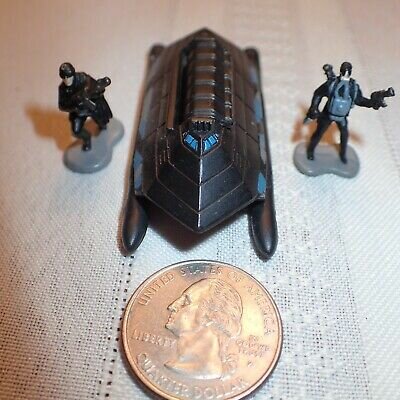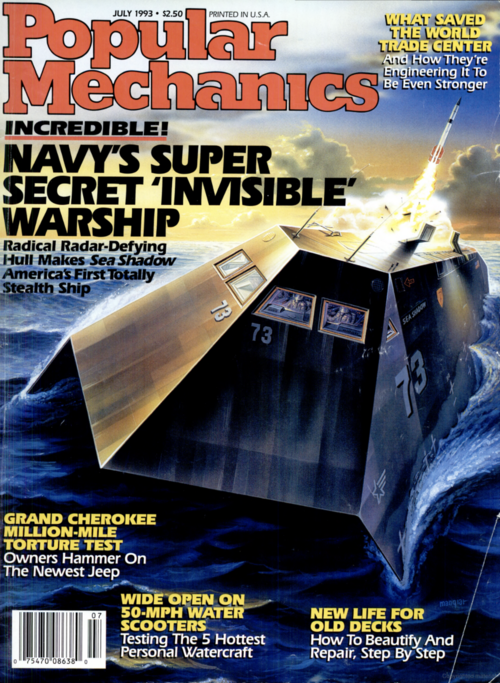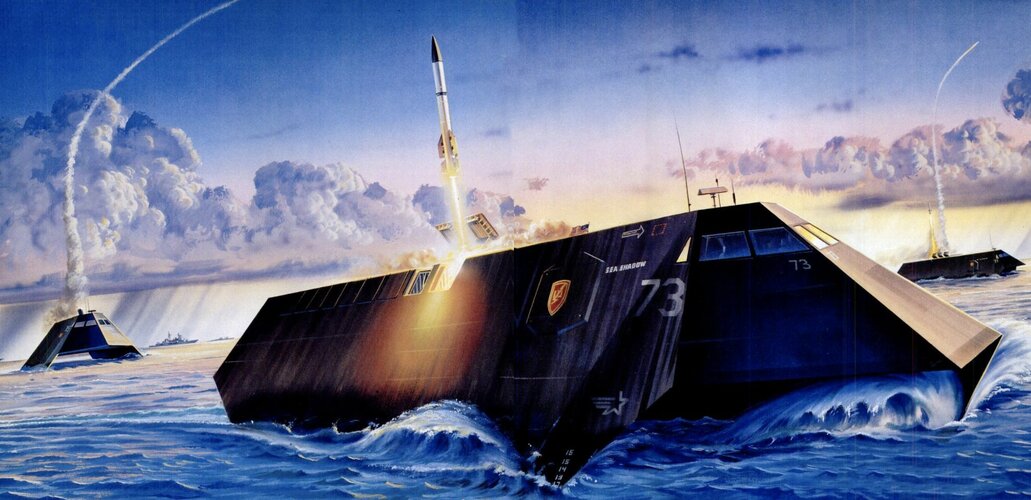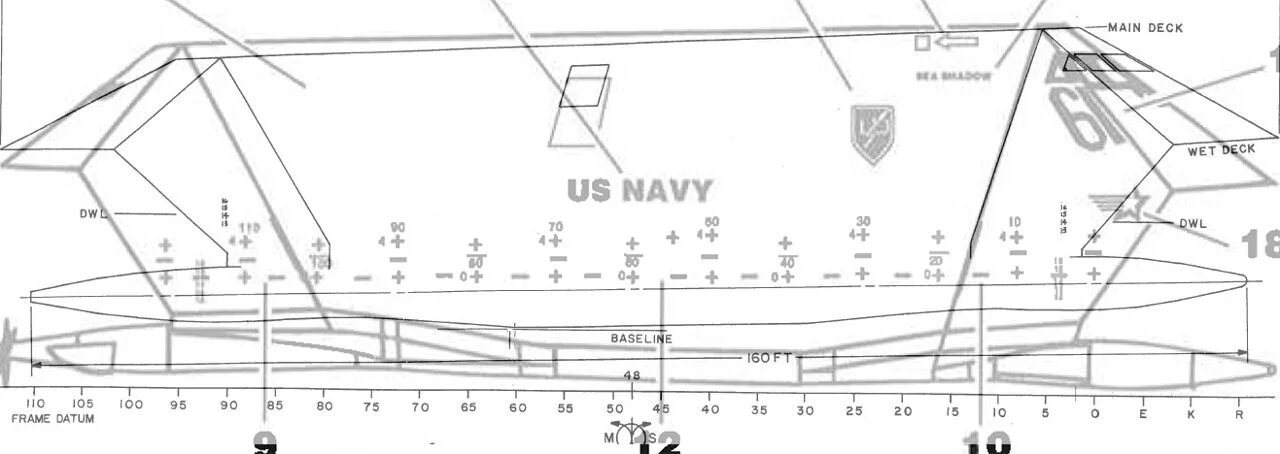You are using an out of date browser. It may not display this or other websites correctly.
You should upgrade or use an alternative browser.
You should upgrade or use an alternative browser.
Lockheed Sea Shadow (IX-529)
- Thread starter flateric
- Start date
- Joined
- 12 July 2008
- Messages
- 394
- Reaction score
- 131
It was offered as a museum ship only if the taker also took the Hughes Mining Barge and displayed Sea Shadow inside of said barge. I don't see the horrible loss, the ship never did anything in service, it has very little on the inside for people to see other then the bridge and the engine room, and the US has too many underfunded museum ships already. Some are literally sinking at anchor.
soundguy20000
I really should change my personal text
- Joined
- 25 January 2013
- Messages
- 1
- Reaction score
- 2
I feel it was a tragic loss that the IX-529 (Sea Shadow) was scrapped, watching the ship being ripped apart, day to day was horrifying, but before I get there a little back story. I found this forum through my Flickr stats, yes I went in January of 2010 with Amy Hieden to the G-Row of the Susuin Bay Mothball Fleet, but we never we allowed on board the Sea Shadow, merely on the HMB-1. In September of 2012 my path once again crossed with the HMB-1 at Treasure Island in San Francisco. From September 2012, until the final scrapping of the Sea Shadow in December of 2012 I made 23 visits to the ships, climbed through almost every compartment of both ships, toured the Sea Shadow with one of the Ex-Lockheed Engineers, and was one of the last people to set foot on the Sea Shadow before it was gone. Through all these visits and once of a lifetime access I developed an understanding of what the US Navy was testing on the Sea Shadow, which goes far beyond the stealth technology and reduced manning that the Navy has explained publicly. As far as I can tell my photographs tell the most complete story of the scrapping and destruction of an amazing ship. When the scrapping kicked up a notch by bringing on three four hundred excavators, the amount of difficulty the scrapping encountered was amazing, including the Sea Shadow sliding forward off it's supports, a bent nose, and the excavators burning through $7,000 heads at an unheard of rate. At the moment my Flickr set is as complete of a public library as I'm posting for now, http://www.flickr.com/photos/soundguy20000/sets/72157631960059129/with/8390152916/
Thanks for looking and reading!
Thanks for looking and reading!
Attachments
- Joined
- 16 April 2008
- Messages
- 8,901
- Reaction score
- 12,243
Not really. The only thing they have in common is the SWATH hullform, and the FSF version is actually quite different -- more of a semi-SWATH approach. Also, FSF-1 isn't notably low-signature (look at the exposed railings, for example).
- Joined
- 1 April 2006
- Messages
- 10,969
- Reaction score
- 8,070
Thanks for sharing, Eric. What a mess...sad loss for history. :'(soundguy20000 said:Thanks for looking and reading!
- Joined
- 16 April 2008
- Messages
- 8,901
- Reaction score
- 12,243
IX-529 was the Navy's hull number. IX indicates "unclassified miscellaneous" and is used for all manner of unusual or uninteresting non-commissioned vessels -- everything from experimental craft like Sea Shadow to barges.
- Joined
- 27 April 2008
- Messages
- 406
- Reaction score
- 127
The Sea Shadow may be gone, but (as a update to my previous post, Reply #34) these two sites have good virtual tours of the Sea Shadow and the Hughes Mining Barge with extensive links to further information:
http://nonplused.org/panos/seashadow/index.html & http://archive.hnsa.org/seashadow/index.php
http://nonplused.org/panos/seashadow/index.html & http://archive.hnsa.org/seashadow/index.php
Anyone know which payloads were *actually* carried in the payload bay of the Sea Shadow?
Made a Covert Shores cutaway of her, article at http://www.hisutton.com/Lockheed-Sea-Shadow-Stealth-Ship.html
Attachments
- Joined
- 3 June 2006
- Messages
- 2,928
- Reaction score
- 3,065
One of Kelly Johnsons' rules was not to work with the US Navy.
- Joined
- 3 September 2006
- Messages
- 1,421
- Reaction score
- 1,308
Interesting article, thanks.Made a Covert Shores cutaway of her, article at http://www.hisutton.com/Lockheed-Sea-Shadow-Stealth-Ship.html
One minor comment, about the sentence "The twin hulls allowed for an extremely angled upper hull which looked completely unlike any ship before it."
Could instead be "...which looked strangely reminiscent of civil war ironclads like css Virginia, uss Cairo, uss Carondelet and their brethen. "
One man's opinion, anyway.
- Joined
- 27 September 2006
- Messages
- 5,983
- Reaction score
- 6,041
- Joined
- 6 September 2006
- Messages
- 4,517
- Reaction score
- 8,262
Sea Shadow hit the zeitgeist of the time when it was revealed in 1993, I was ten at the time and thought I was looking at the future. Almost immediately Electronic Arts put it into the videogame Urban Strike in 1994 (set in 2001). Everyone assumed this was the stealth fighter for the seas but it never worked out like that and today's stealth shaping for naval vessels has never gone to these lengths. Indeed even SWATH has fallen from favour since the late 80s/early 90s too.
I'm still curious how effective it really was, it seems to have had some input into USN programmes but seems very much to have been a DARPA project that the USN never really brought into or cared about.
I'm also curious as to how much of the design work was done by Skunk Works and how much by Lochkeed Shipbuilding, being an aviation company it would seem incredible that they designed and built a novel ship from the keel(s) up without any problems when they were not nautical architects. Perhaps this was another reason why the USN distrusted the programme?
I'm still curious how effective it really was, it seems to have had some input into USN programmes but seems very much to have been a DARPA project that the USN never really brought into or cared about.
I'm also curious as to how much of the design work was done by Skunk Works and how much by Lochkeed Shipbuilding, being an aviation company it would seem incredible that they designed and built a novel ship from the keel(s) up without any problems when they were not nautical architects. Perhaps this was another reason why the USN distrusted the programme?
Lots of good info at San Francisco Maritime National Park Association website.
These would have probably been quite useful:
Sea Shadow Manual
Docking plan
'Virtual tour' panormas:
These would have probably been quite useful:
Sea Shadow Manual
Docking plan
'Virtual tour' panormas:
- Inside HMB-1 Sea Shadow Bow, another view
- Inside HMB-1 Under Sea Shadow
- Inside HMB-1, Sea Shadow Stern, another view
- Inside HMB-1, Starboard view of Sea Shadow
- Entry
- Payload space
- Switchgear passage, Switchgear room
- Generator room, Another view
- Galley/Passage
- Bridge
- First Platform Passage
- Berthing
- Aux Machinery Room 1
- I.C. Switch Room
- Electronics room
- Bosun's Storeroom
- Starboard Canard Room
- Starboard Pump Room
- Stb. Aft Passage
- Starboard Stabilizer Room
- Starboard Motor Room
- HMB-1 Wing Wall
- HMB-1 Ballast Control Room
Attachments
Last edited:
Related to Sea Shadow; a new Covert Shores article on the stealthy submarine developed by Lockheed. This is based on a sketch I drew of a design illustrated in an issue of Armada International in the mid 1990s, so has 25 years of uncertanty associated with it.
Sonar-Invisible Submarine
Sonar-Invisible Submarine
X-39
To post or not to post, that is the question
- Joined
- 20 February 2021
- Messages
- 382
- Reaction score
- 906
Aeroengineer1
Engineering, not just a job, but a lifestyle :)
- Joined
- 27 January 2008
- Messages
- 121
- Reaction score
- 99
Is this a comparison of the Revel kit plans vs the Manual?
- Joined
- 1 April 2006
- Messages
- 10,969
- Reaction score
- 8,070
yes. note that I didn't care of getting kit drawing to scale (results would be even worse me thinks)Is this a comparison of the Revel kit plans vs the Manual?
Lots of good info at San Francisco Maritime National Park Association website.
These would have probably been quite useful:
Sea Shadow Manual
Saving some of these PDFs here for posterity.
- The Sea Shadow, Naval Engineers Journal, May 1994
- Sea Shadow 1983 to 2006 (slides & photos)
- Sea Shadow manual, Navsea
Attachments
Just edited my post, now with docking plan pdf as attachmentSaving some of these PDFs here for posterity.
- The Sea Shadow, Naval Engineers Journal, May 1994
- Sea Shadow 1983 to 2006 (slides & photos)
- Sea Shadow manual, Navsea
iwantmoresources
ACCESS: Restricted
- Joined
- 10 April 2023
- Messages
- 34
- Reaction score
- 41
The German Wikipedia page on the Sea Shadow makes a very interesting claim:
“Nach zwei Jahren des Testens strich der Chief of Naval Operations, Admiral James D. Watkins, 1986 das Programm schließlich, laut Rich aufgrund von Streichungen im Budget der Navy. Es hatte sich herausgestellt, dass Schiffsradare, welche die Wellen der Wasseroberfläche abbildeten, die Umrisse des Schiffes deutlich als „wellenlose Oberfläche“ auf dem Radarschirm zeigten. Um dies zu vermeiden, hätte das Schiff das Radarecho der umgebenden Wellen simulieren müssen, wäre dann aber darüber leicht elektronisch detektierbar gewesen.”
“After two years, Chief of Naval Operations Admiral James D. Watkins, cancelled the program in 1986 due to cuts in the Navy’s Budget, according to Rich. It turned out that ship radars, which depicted the waves on the surface, showed the outline of the ship clearly as “waveless surface” on the radar screen. To avoid this, the ship would have had to simulate the radar echo of the surrounding waves, which would have made the ship easily detectable by electronic means.”
It sounds very plausible, but i am not fully convinced. Does someone know more about this?
Edit: this passage didn’t have any sources, which is why i distrust it. Also, wouldn’t this mean that in any sea state detectable by radar, a stealth ship would show up as an empty outline that one could vector strike assets towards? E.g. an F-18 with radar in sea mode would be able to see the outline of a stealth ship in any sea state beyond moderate (just an example).
“Nach zwei Jahren des Testens strich der Chief of Naval Operations, Admiral James D. Watkins, 1986 das Programm schließlich, laut Rich aufgrund von Streichungen im Budget der Navy. Es hatte sich herausgestellt, dass Schiffsradare, welche die Wellen der Wasseroberfläche abbildeten, die Umrisse des Schiffes deutlich als „wellenlose Oberfläche“ auf dem Radarschirm zeigten. Um dies zu vermeiden, hätte das Schiff das Radarecho der umgebenden Wellen simulieren müssen, wäre dann aber darüber leicht elektronisch detektierbar gewesen.”
“After two years, Chief of Naval Operations Admiral James D. Watkins, cancelled the program in 1986 due to cuts in the Navy’s Budget, according to Rich. It turned out that ship radars, which depicted the waves on the surface, showed the outline of the ship clearly as “waveless surface” on the radar screen. To avoid this, the ship would have had to simulate the radar echo of the surrounding waves, which would have made the ship easily detectable by electronic means.”
It sounds very plausible, but i am not fully convinced. Does someone know more about this?
Edit: this passage didn’t have any sources, which is why i distrust it. Also, wouldn’t this mean that in any sea state detectable by radar, a stealth ship would show up as an empty outline that one could vector strike assets towards? E.g. an F-18 with radar in sea mode would be able to see the outline of a stealth ship in any sea state beyond moderate (just an example).
Last edited:
- Joined
- 3 June 2006
- Messages
- 2,928
- Reaction score
- 3,065
The passage is based by this book:The German Wikipedia page on the Sea Shadow makes a very interesting claim:
It sounds very plausible, but i am not fully convinced. Does someone know more about this?
Edit: this passage didn’t have any sources, which is why i distrust it. Also, wouldn’t this mean that in any sea state detectable by radar, a stealth ship would show up as an empty outline that one could vector strike assets towards?
Skunk Works: A Personal Memoir of My Years at Lockheed, by Ben R. Rich and Leo Janos, chapter 13 THE SHIP THAT NEVER WAS.
[...] One of the biggest problems we had to overcome was our own extreme invisibility! The ocean waves showed up on radar like a string of tracer bullets. And if the ship was totally invisible, it looked like a blank spot—like a hole in the doughnut—that was a dead giveaway. In the stealth business, you tried like the devil not to be quieter than the background noise, because that was like a trumpet-blast warning to the enemy.
By the time we solved this problem, however, the admirals who ran the surface fleet were displaying little enthusiasm for going any speed ahead. “Too radical a design,” they told me. “If the shape is so revolutionary and secret, how could we ever use it without hundreds of sailors seeing it? It’s just too far out.” There were sexier ways of spending naval appropriations than on a small secret ship that would win few political brownie points for any admiral who pushed for it. Although the Navy did apply our technology to lower the cross section of submarine periscopes and reduce the radar cross section of their new class of destroyers, we were drydocked before we had really got launched. So I held back: I had a design for a stealthy aircraft carrier that would show up on radar no bigger than a life raft, but I had already proven Kelly’s unwritten Rule Fifteen about dealing with the Navy. Why ignore it twice?
iwantmoresources
ACCESS: Restricted
- Joined
- 10 April 2023
- Messages
- 34
- Reaction score
- 41
Correct me if im wrong, but even if the Sea Shadow (or its derivative) was detectable because of the ship-shaped patch of perfectly calm sea, no Soviet anti ship missile would be able to target it, given the lack of radar reflections. Which means the Soviets would have to send aircraft to within visual range to sink it, and all weaponized Sea Shadow concepts i see are armed with medium/long range SAMs. Or sink it with guns.
So, even if it was detected, Soviet strike aircraft would have to evade RIM-67 or even MIM-104 and potentially RIM-7/162/116. That means the Soviets have two options: perform a mass attack from all sides to overwhelm the air defenses and experience unsustainable loss rates, or risk a ship to try and sink it with guns. And given that there would be multiple of these things in theatre, i would expect these things to at least be a massive nuisance.
So, even if it was detected, Soviet strike aircraft would have to evade RIM-67 or even MIM-104 and potentially RIM-7/162/116. That means the Soviets have two options: perform a mass attack from all sides to overwhelm the air defenses and experience unsustainable loss rates, or risk a ship to try and sink it with guns. And given that there would be multiple of these things in theatre, i would expect these things to at least be a massive nuisance.
- Joined
- 16 April 2008
- Messages
- 8,901
- Reaction score
- 12,243
Correct me if im wrong, but even if the Sea Shadow (or its derivative) was detectable because of the ship-shaped patch of perfectly calm sea, no Soviet anti ship missile would be able to target it, given the lack of radar reflections. Which means the Soviets would have to send aircraft to within visual range to sink it, and all weaponized Sea Shadow concepts i see are armed with medium/long range SAMs. Or sink it with guns.
So, even if it was detected, Soviet strike aircraft would have to evade RIM-67 or even MIM-104 and potentially RIM-7/162/116. That means the Soviets have two options: perform a mass attack from all sides to overwhelm the air defenses and experience unsustainable loss rates, or risk a ship to try and sink it with guns. And given that there would be multiple of these things in theatre, i would expect these things to at least be a massive nuisance.
No, that's a major oversimplification.
1) A radar-guided missile that got close enough to a stealth ship would still be able to detect and home on it. Soviet reconnaissance-strike complexes were already set up to provide the sort of off-board guidance required for this.
2) Armed Sea Shadows with the weapons described would have to emit active radar to guide their own missiles, and the Soviets would likely adapt by using passive radar homing seekers on at least some missiles.
A Tentative Fleet Plan
I really should change my personal text
- Joined
- 9 April 2018
- Messages
- 1,128
- Reaction score
- 2,431
Soviets also had IR seekers on some anti-ship missiles.
Scott Kenny
ACCESS: Above Top Secret
- Joined
- 15 May 2023
- Messages
- 8,043
- Reaction score
- 8,271
IIRC, Sea Shadow did mostly address that issue, the diesels exhausted under the hull where the hot exhaust got mixed with all the air going between the SWATH sideplates.Soviets also had IR seekers on some anti-ship missiles.
And it wouldn't be hard to add a cogeneration system to pull more heat out of the exhaust to bring it down to ambient temp even without mixing it under the hull.
Similar threads
-
1989 REVELL 1/400 SOVIET Typhoon SSBN plastic model kit / "Red October"
- Started by fightingirish
- Replies: 0
-
-
2 NEW 1-48th STRATOSPHERE MODELS KITS AT SHAPEWAYS ! GTD-21 Booster & Dolly
- Started by Desert Dawn
- Replies: 0
-
OA Vulcan goes Bear hunting...(and Foxbats...and Backfires...): The Vulcan ADV
- Started by Overkiller
- Replies: 12
-
US Navy 18" gun battleship design: BB61 "slow" scheme from April 1938
- Started by icyplanetnhc (Steve)
- Replies: 3

